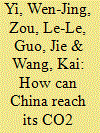|
|
|
Sort Order |
|
|
|
Items / Page
|
|
|
|
|
|
|
| Srl | Item |
| 1 |
ID:
104898


|
|
|
|
|
| Publication |
2011.
|
| Summary/Abstract |
In late 2009, the Chinese government committed to cut its carbon dioxide emissions per unit of gross domestic product (GDP) by 40% to 45% of 2005 levels by 2020. This has raised the issue of how to allocate the CO2 reduction target regionally to meet the national reduction target. To meet this objective, the following aspects may be taken into consideration: equity principles, 'common but differentiated responsibilities'; intensity reduction target fulfillment; and economic difference and reduction potential among provinces. This paper selects per capita GDP, accumulated fossil fuel related CO2 emissions and energy consumption per unit of industrial added value as indicators for emission reduction capacity, responsibility and potential, respectively. Based on these three indicators, a comprehensive index is developed and an intensity allocation model constructed. As decision makers may have different preferences when allocating the reduction burden, we allocate different weights to the indicators, analyzing the results using cluster analysis. The following aspects may also be considered together with the national regional development strategy to determine how to share the burden: the reduction potential of various regions; implementation potential of the plans; and promotion of a highly efficient low carbon economic development model.
|
|
|
|
|
|
|
|
|
|
|
|
|
|
|
|
| 2 |
ID:
094245


|
|
|
|
|
| Publication |
2010.
|
| Summary/Abstract |
This paper attempts to discuss the CO2 emissions embodied in Sino-US international trade using a sector approach. Based on an input-output model established in this study, we quantify the impact of Sino-US international trade on national and global CO2 emissions. Our initial findings reveal that: In 2005, the US reduced 190.13 Mt CO2 emissions through the consumption of imported goods from China, while increasing global CO2 emissions by about 515.25 Mt. Similarly, China reduced 178.62 Mt CO2 emissions through the consumption of US goods, while reducing global CO2 emissions by 129.93 Mt. Sino-US international trade increased global CO2 emissions by 385.32 Mt as a whole, of which the Chemical, Fabricated Metal Products, Non-metallic Mineral Products and Transportation Equipment sectors contributed an 86.71% share. Therefore, we suggest that accelerating the adjustment of China's trade structure and export of US advanced technologies and experience related to clean production and energy efficiency to China as the way to reduce the negative impact of Sino-US trade on national and global CO2 emissions. This behavior should take into account the processing and manufacturing industries as a priority, especially the Chemical, Fabricated Metal Products, Non-metallic Mineral Products and Transportation Equipment sectors.
|
|
|
|
|
|
|
|
|
|
|
|
|
|
|
|
|
|
|
|
|